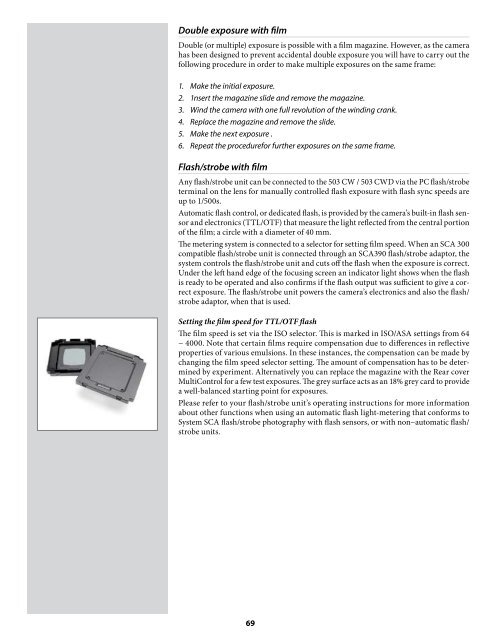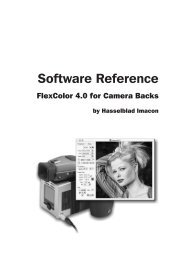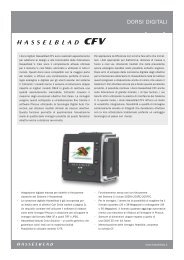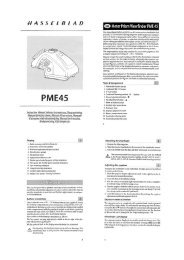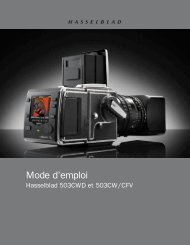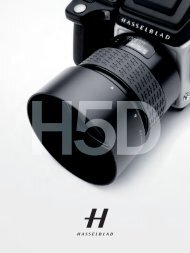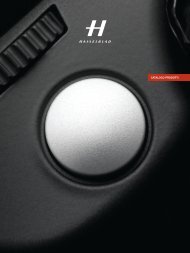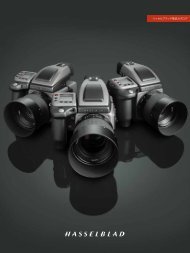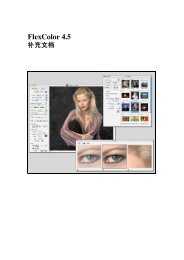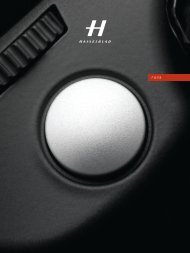User Manual - Hasselblad.jp
User Manual - Hasselblad.jp
User Manual - Hasselblad.jp
Create successful ePaper yourself
Turn your PDF publications into a flip-book with our unique Google optimized e-Paper software.
Double exposure with film<br />
Double (or multiple) exposure is possible with a film magazine. However, as the camera<br />
has been designed to prevent accidental double exposure you will have to carry out the<br />
following procedure in order to make multiple exposures on the same frame:<br />
1. Make the initial exposure.<br />
2. 1nsert the magazine slide and remove the magazine.<br />
3. Wind the camera with one full revolution of the winding crank.<br />
4. Replace the magazine and remove the slide.<br />
5. Make the next exposure .<br />
6. Repeat the procedurefor further exposures on the same frame.<br />
Flash/strobe with film<br />
Any flash/strobe unit can be connected to the 503 CW / 503 CWD via the PC flash/strobe<br />
terminal on the lens for manually controlled flash exposure with flash sync speeds are<br />
up to 1/500s.<br />
Automatic flash control, or dedicated flash, is provided by the camera’s built-in flash sensor<br />
and electronics (TTL/OTF) that measure the light reflected from the central portion<br />
of the film; a circle with a diameter of 40 mm.<br />
The metering system is connected to a selector for setting film speed. When an SCA 300<br />
compatible flash/strobe unit is connected through an SCA390 flash/strobe adaptor, the<br />
system controls the flash/strobe unit and cuts off the flash when the exposure is correct.<br />
Under the left hand edge of the focusing screen an indicator light shows when the flash<br />
is ready to be operated and also confirms if the flash output was sufficient to give a correct<br />
exposure. The flash/strobe unit powers the camera’s electronics and also the flash/<br />
strobe adaptor, when that is used.<br />
Setting the film speed for TTL/OTF flash<br />
The film speed is set via the ISO selector. This is marked in ISO/ASA settings from 64<br />
− 4000. Note that certain films require compensation due to differences in reflective<br />
properties of various emulsions. In these instances, the compensation can be made by<br />
changing the film speed selector setting. The amount of compensation has to be determined<br />
by experiment. Alternatively you can replace the magazine with the Rear cover<br />
MultiControl for a few test exposures. The grey surface acts as an 18% grey card to provide<br />
a well-balanced starting point for exposures.<br />
Please refer to your flash/strobe unit’s operating instructions for more information<br />
about other functions when using an automatic flash light-metering that conforms to<br />
System SCA flash/strobe photography with flash sensors, or with non−automatic flash/<br />
strobe units.<br />
69


